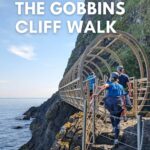If you’re looking for a fun activity in Northern Ireland combining natural beauty, history, and a dash of adrenaline, look no further than The Gobbins cliff path.
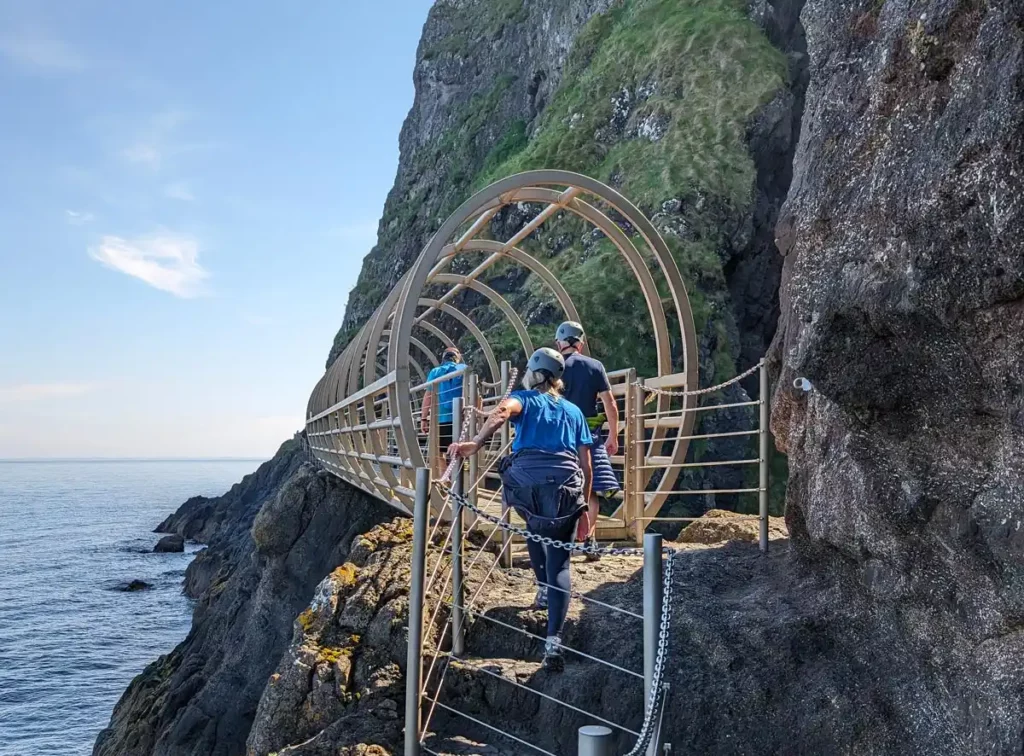
This stunning coastal walk, located on the Causeway Coastal Route, offers visitors a unique opportunity to explore the rugged coastline and experience the raw power of the Irish Sea. I did the Gobbins cliff path hike in May 2024, and it was one of my favourite things to do in Northern Ireland. In this post, I’ll tell you what to expect, what you can see and provide some tips for your trip.
Update May 2025: The Gobbins is currently closed after some rockfalls along the path. They are working to reopen it as soon as possible.
What is the Gobbins?
The Gobbins is a spectacular cliff path that hugs the basalt cliffs of the County Antrim coastline. First opened in 1902, the path was designed by Berkeley Deane Wise, a railway engineer who wanted to create a tourist attraction that would rival the Giant’s Causeway. The original path closed to the public in the 1950s and fell into disrepair. Sixty years later, it was restored and reopened to the public in 2015.
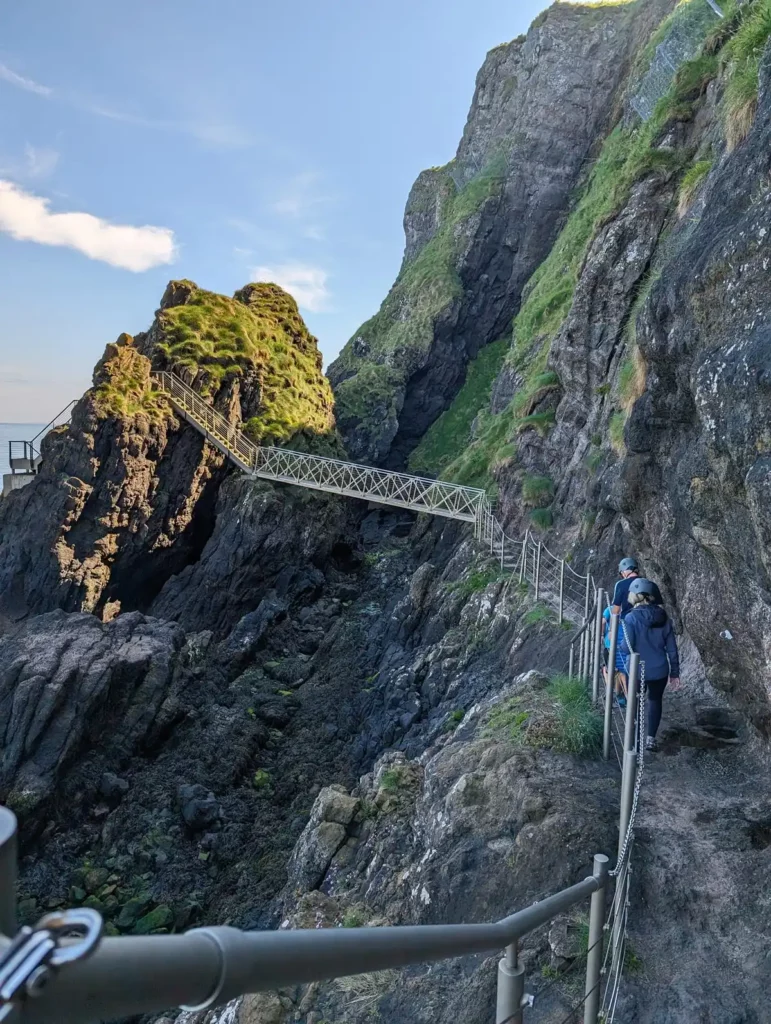
The guided walk along the Gobbins cliff path stretches for approximately 2 miles, with another mile to get to and from the start of the hike. It takes visitors through a series of bridges, tunnels, and walkways that are carved into the cliffs. The path winds around the base of the cliffs, almost at sea level; if you do the walk at high tide you’ll have the waves right below you!
On our trip we saw (and smelled!) hundreds of seabirds, including razorbills, kittiwakes and cormorants. If you’re very lucky, you may catch a glimpse of puffins; the Gobbins is the only spot on the Northern Ireland mainland where they breed. Our guide said he’d occasionally seen dolphins and porpoises off the rocky coast.
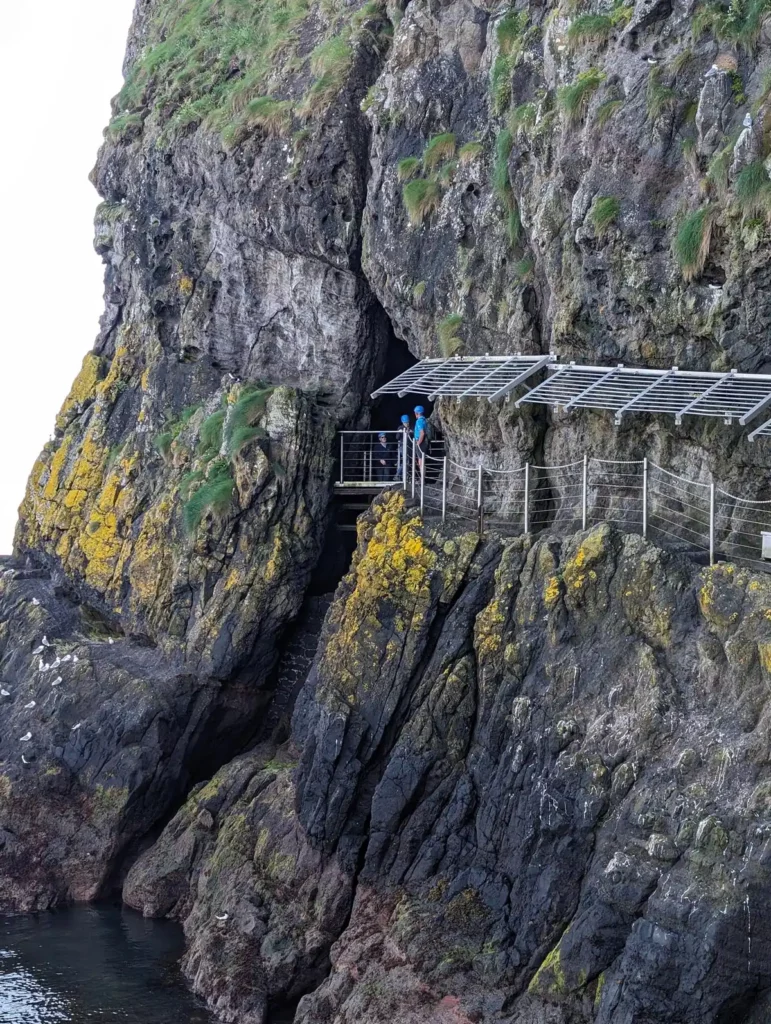
What to expect on the Gobbins walk
The trip starts at the visitor centre
There’s no public access to the path, so you’ll need to take a guided tour. There are several tours each day, and you should book in advance as they almost always sell out.
The tour starts at the Gobbins Visitor Centre (Google Maps link), which is just north of the village of Ballystrudder. There’s parking right outside the visitor centre (although not quite enough, so get there early!), a cafe, toilets and a small exhibition about the history of the Gobbins.
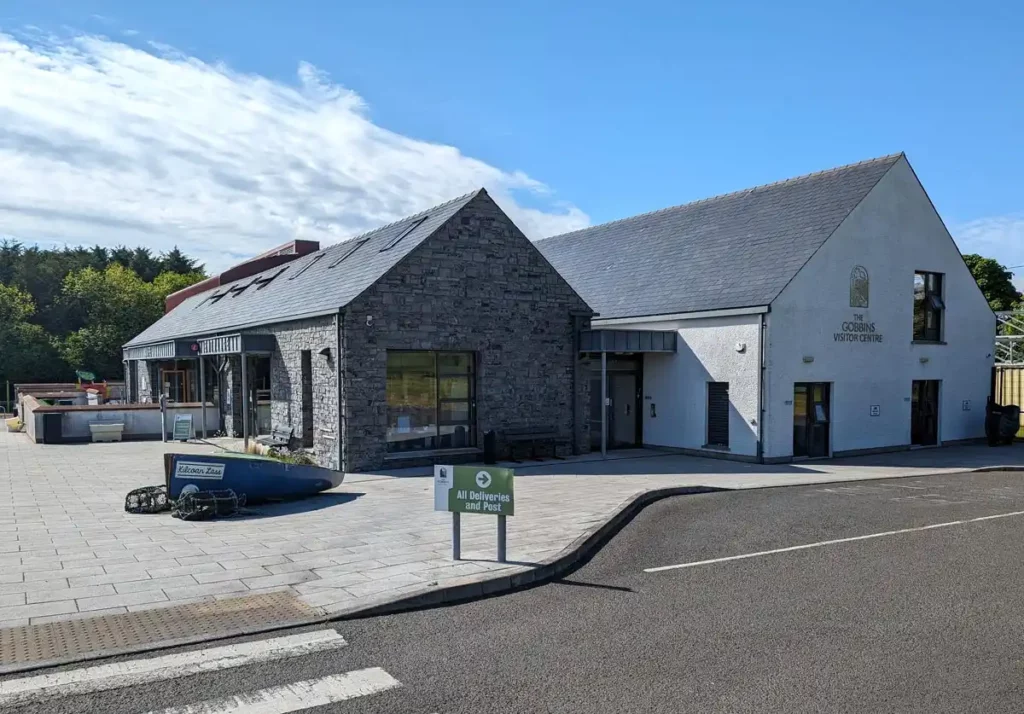
Before you set off
You’ll need to report to the front desk of the visitor centre at least 15 minutes before your tour. A few minutes before the tour starts, you’ll meet your guide for a safety briefing and to get your hard hat.
The guide will also check your footwear; you have to wear proper hiking boots with thick soles, a good grip and ankle coverage, although you might be allowed on the trail with substantial walking shoes as long as it’s dry. Trainers aren’t allowed.
I had my own walking boots but if you don’t have suitable boots with you, you can hire a pair at the visitor centre for £5. They only have a limited number of pairs, so it’s best if you can bring your own.
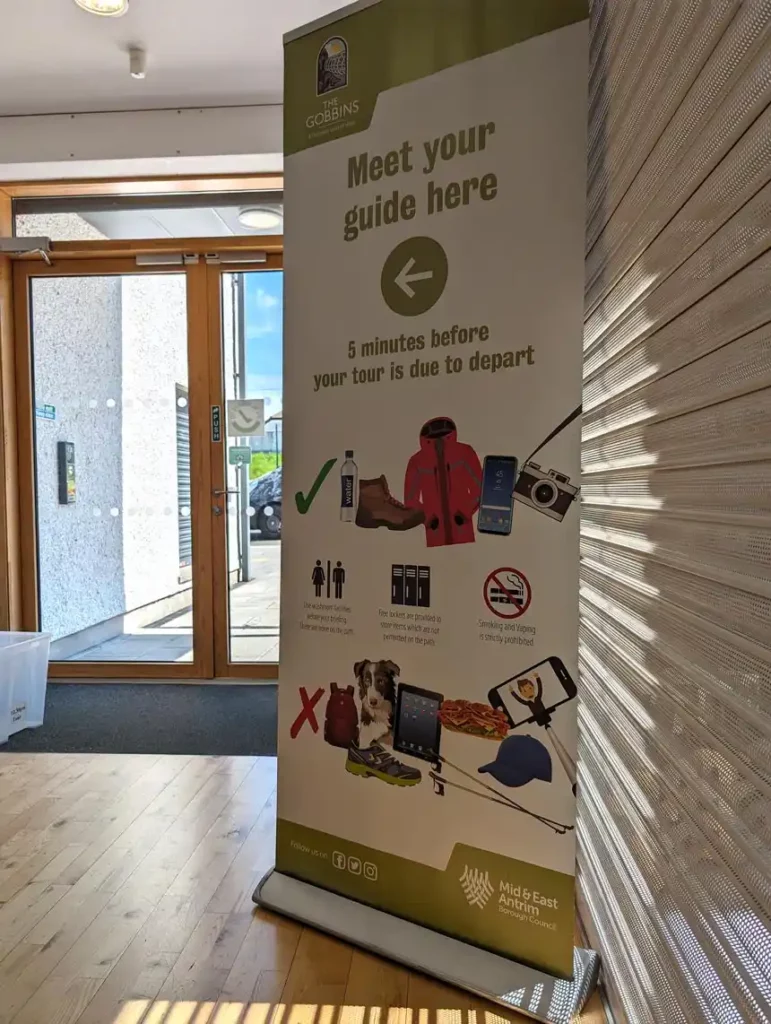
The safety briefing is very short, but the guide will warn you that if you have a heart condition, asthma, knee or hip problems or any other condition that might make it difficult for you to do the walk. There was someone in our group who asked if they could bring a walking pole; the guide said it wouldn’t be allowed on the walk itself but they could bring it to get up and down the hill to the start of the Gobbins walk. While we were on the Gobbins, it was stored safely behind the access gate.
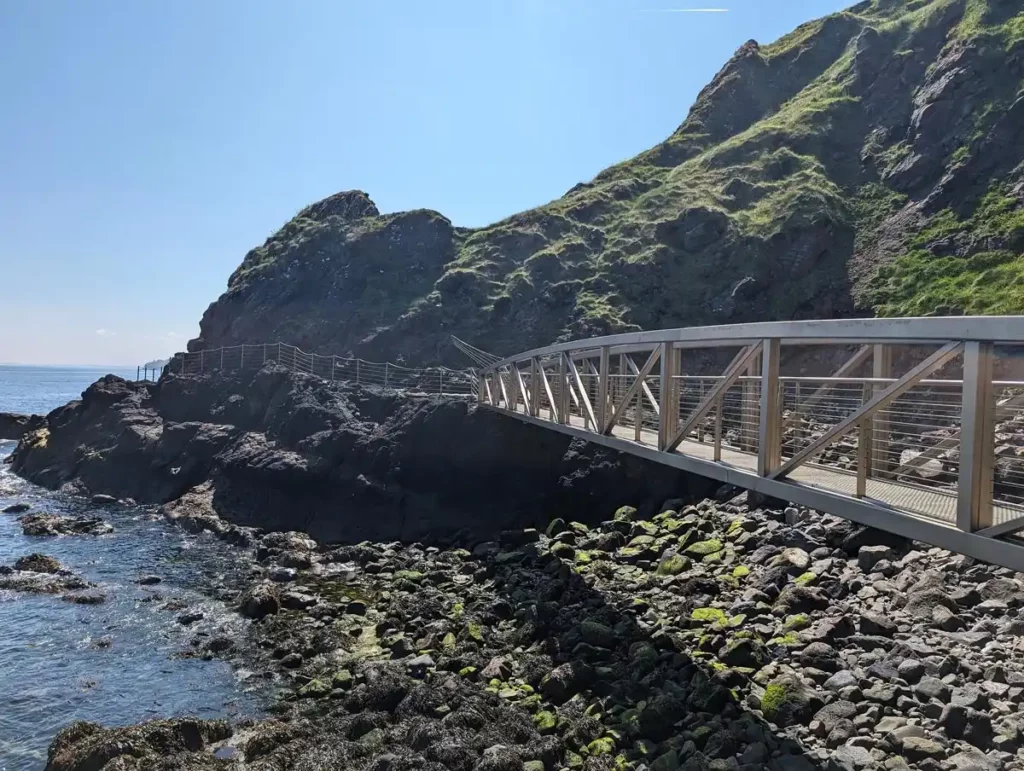
You need both hands free during the walk, and you’re not allowed to bring a bag with you, but they do recommend bringing some water. I put mine in my jacket pocket and tied my jacket around my waist. You can’t bring food with you but I was really anxious about feeling faint so I put a little packet of raisins in my pocket. There are lockers at the visitor centre where you can leave your bags.
Children aged about 7 and above can come on the Gobbins path as long as they’re over 4ft/1.2m tall. Dogs aren’t allowed.
Getting to the start of the path
Once you’ve all got your hard hats and had your safety briefing, you’ll get on board the minibus for a short ride to the start of the Gobbins cliff path.
The bus pulls over in a layby at the top of the cliff, then you’ll walk for about half a mile down a very steep, narrow lane to get to the entrance to the path. Our guide warned us during our safety briefing that getting back up this lane at the end of the walk is the most strenuous bit, and he was absolutely right!
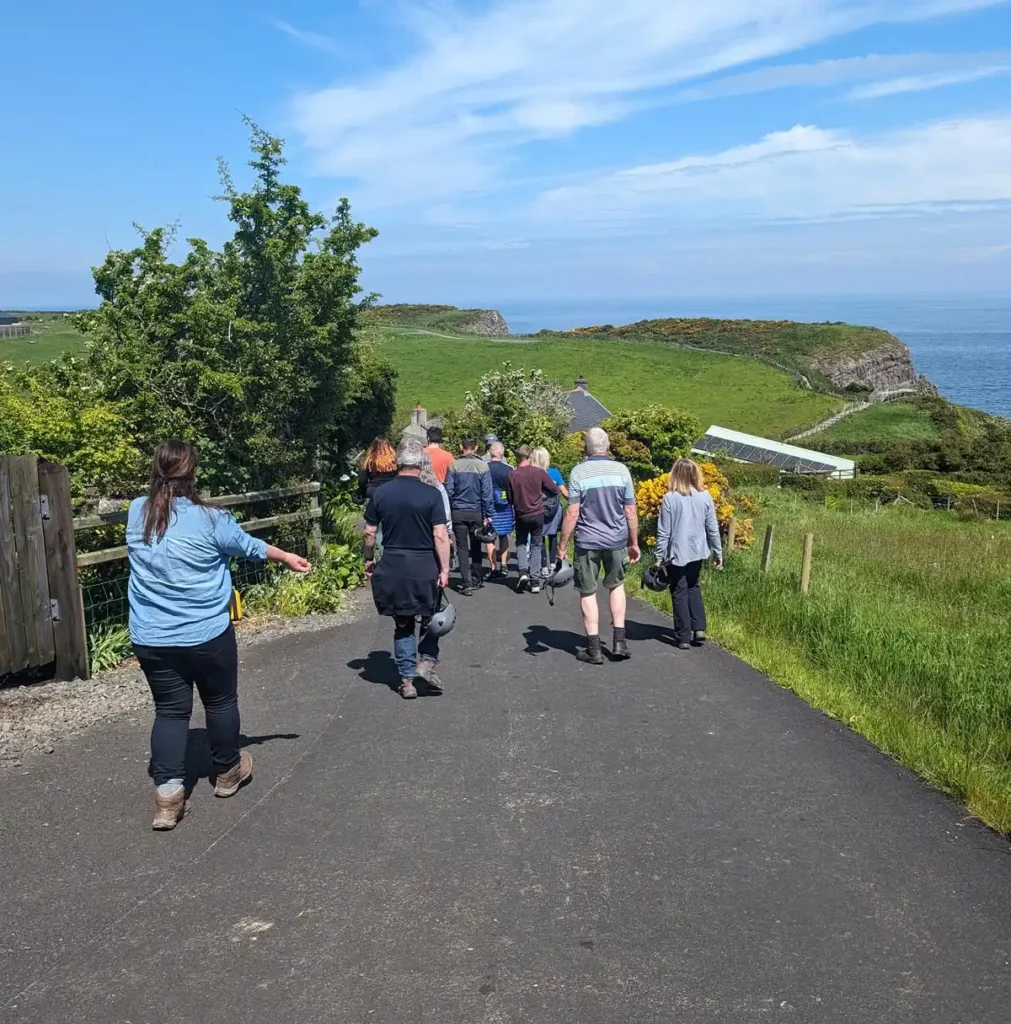
Walking the Gobbins cliff path
The walk itself is approximately 2 miles long and the whole trip takes around 2.5 hours to complete. It’s exciting right from the start, as you slip through Wise’s Eye, a narrow gap in the rock, named after the path’s creator, railway engineer Berkeley Deane Wise.
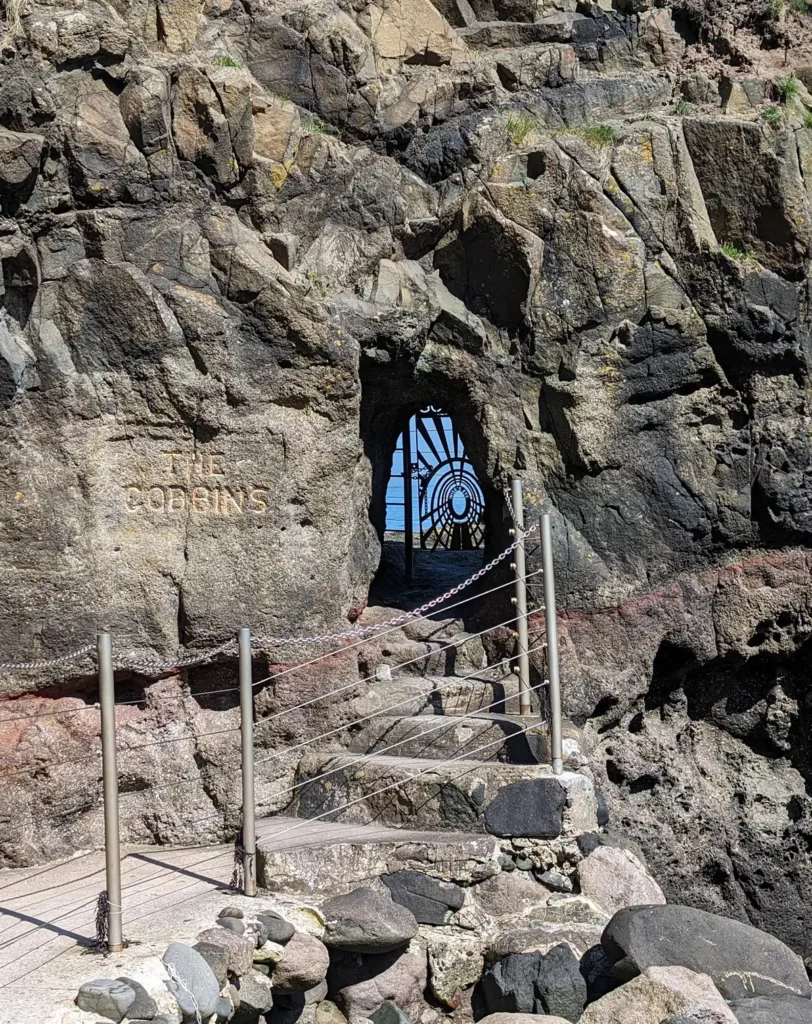
You’ll follow your guide along the path in single file, stopping every few minutes so they can tell you about the history of the path, the nature that you’ll see, and other interesting facts about this part of Northern Ireland. Did you know that if you’d stood on the Gobbins path in April 1912, you would have seen the Titanic undergoing sea trials?
The guide will also point out the original, 100-year-old handrail posts. The path follows the original route for almost all its length, except where a landslide covered the route. The metal bridges are new, as the old ones were unsafe, but follow the same design, and everything else is as it was when it was first carved out of the cliff in the early 1900s. There are lots of sections where you’ll be on a narrow, uneven path, and the (many!) steps can be steep and high.
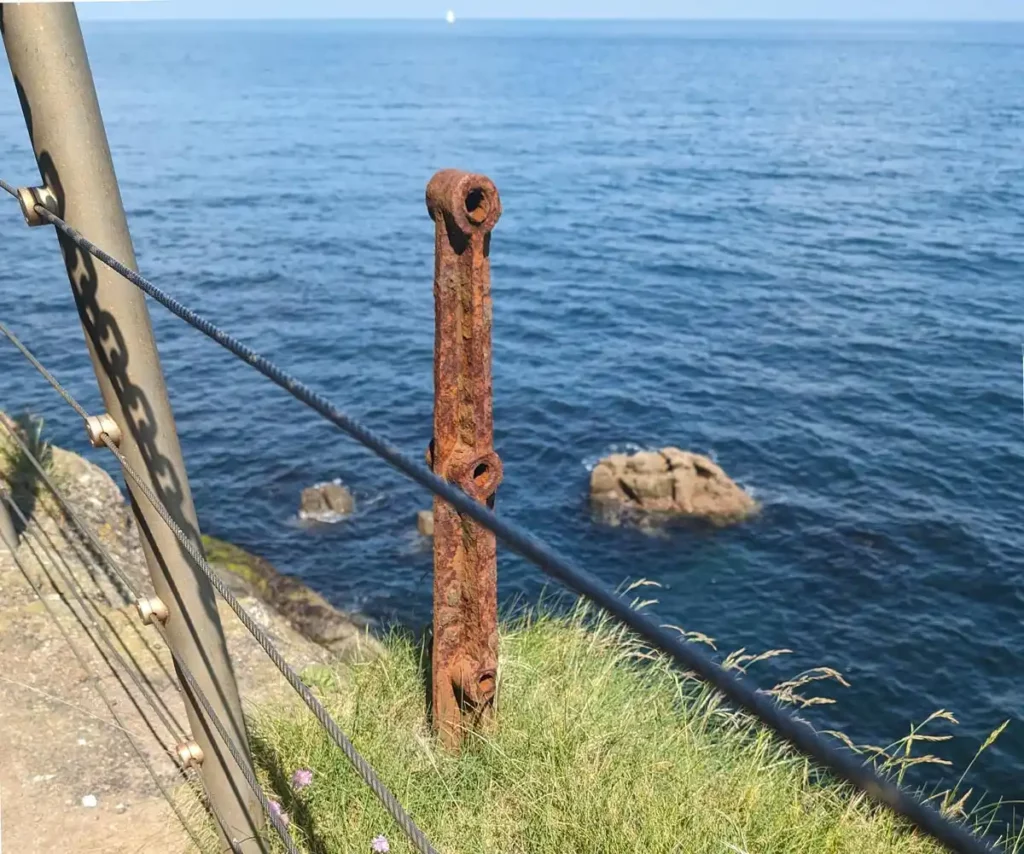
Would you like to save this?
One of the most fun sections is where you go down a steep set of steps into a dark cave, across a metal bridge inside the cave and up and out via another staircase. This is also the part where you’ll realise why everyone has to wear a hard hat – the uneven roof of the cave means you have to dodge bits of rock coming at you as you negotiate the steps!
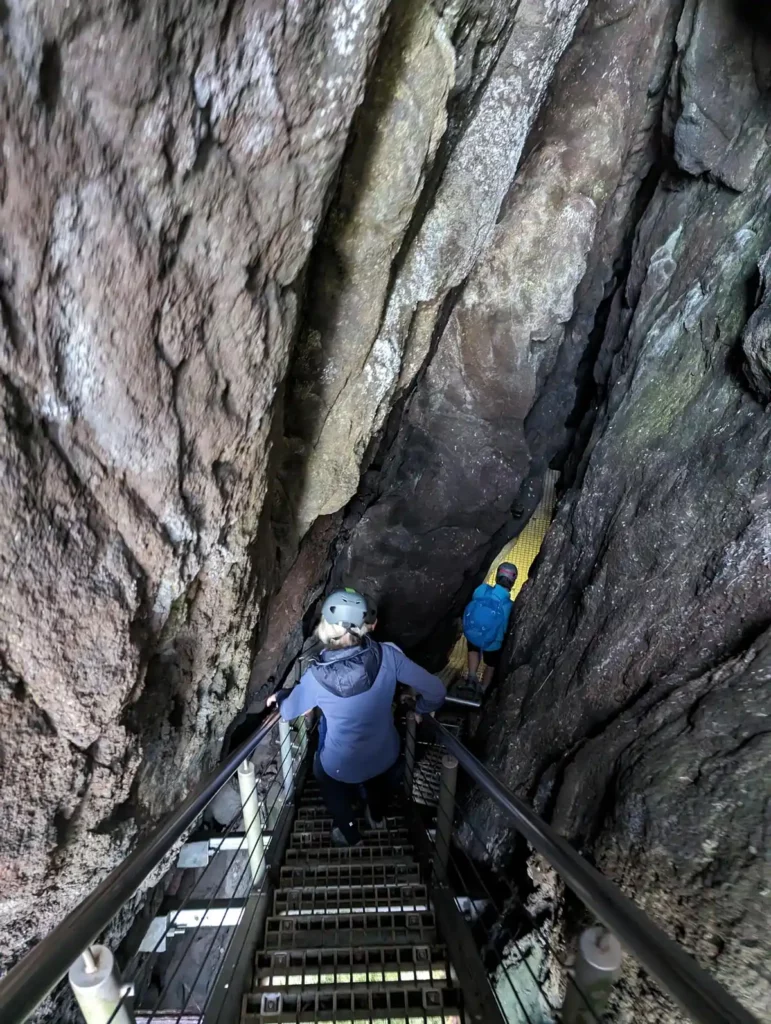
Another highlight of the walk is the Tubular Bridge. It’s a new bridge, but it’s a recreation of the original Tubular Bridge which featured in lots of Edwardian postcards and advertisements. Our guide offered to take photos of us on the bridge which was a lovely touch.
It’s likely that there will be other groups on the path at the same time, so at points the guide will pause the walk on a bridge so the other group can get past.
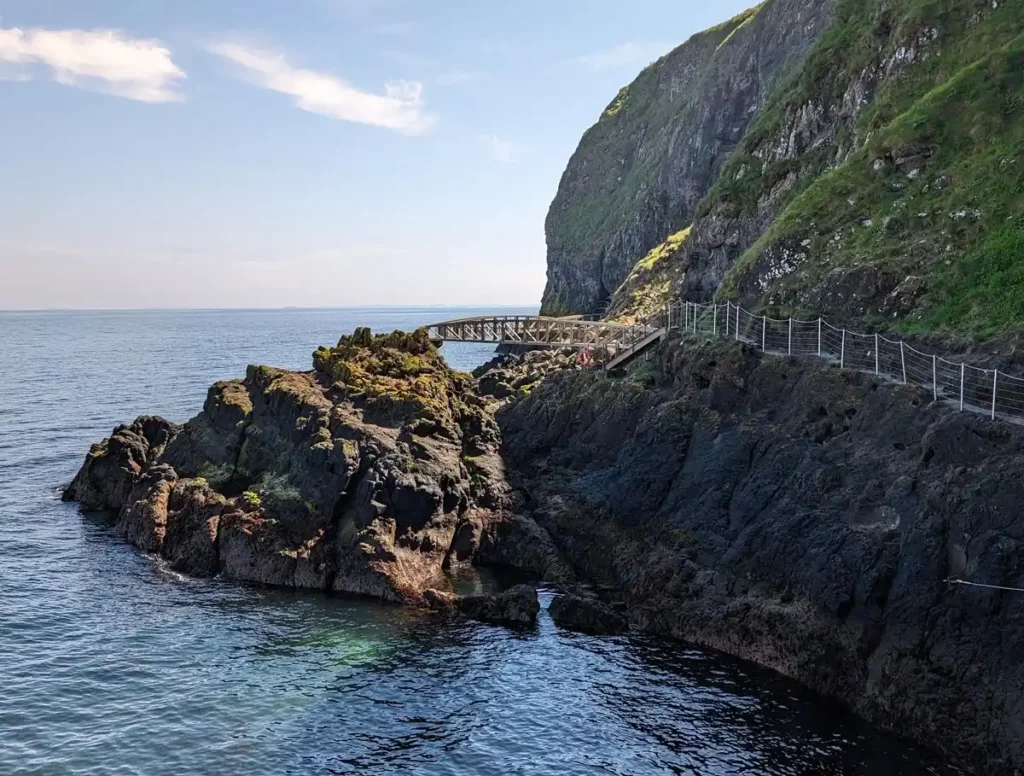
At the end of the walk, you’ll reach a viewpoint where you can stop and enjoy the views of the Irish Sea, the cliffs, and the birds all around you. There was a razorbill sat right in front of us preening itself.
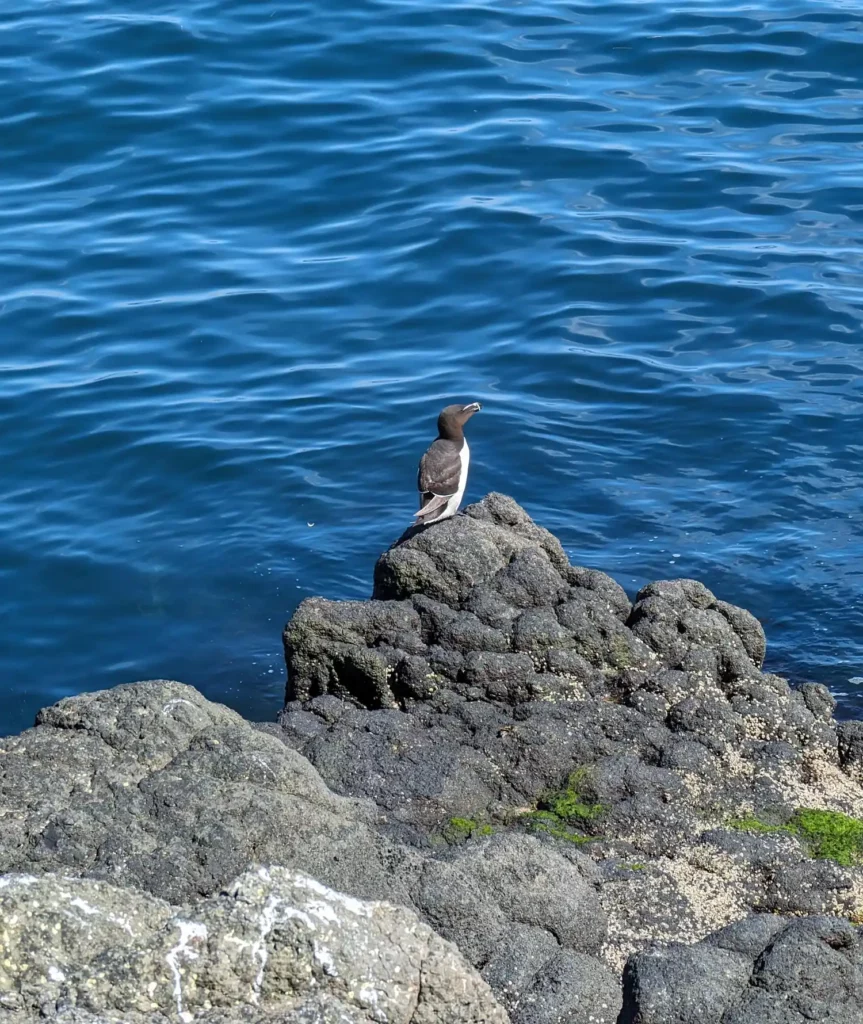
The Gobbins is currently an out-and-back walk, so you’ll return to the Wise’s Eye entrance back the way you came. It’s not ideal, but it does mean that you’ve got another chance to take photos if there’s something you missed on the way. The people who operate the Gobbins are hoping to make some changes in the future to be able to make it a more circular route, but that seems like it’s quite a way off for now.
Once you’re all back at Wise’s Eye, the guide will make sure nobody’s been lost along the way, and will lock the gate behind you. Then it’s back up the steep hill to the bus – by far the worst bit. It was a warm sunny day when I visited the Gobbins and we were all a bit sweaty by the time we got to the top!
After completing the cliff path, you’ll return to the visitor centre by bus, where you can visit the gift shop, take a look at the exhibition or get something to eat in the cafe.
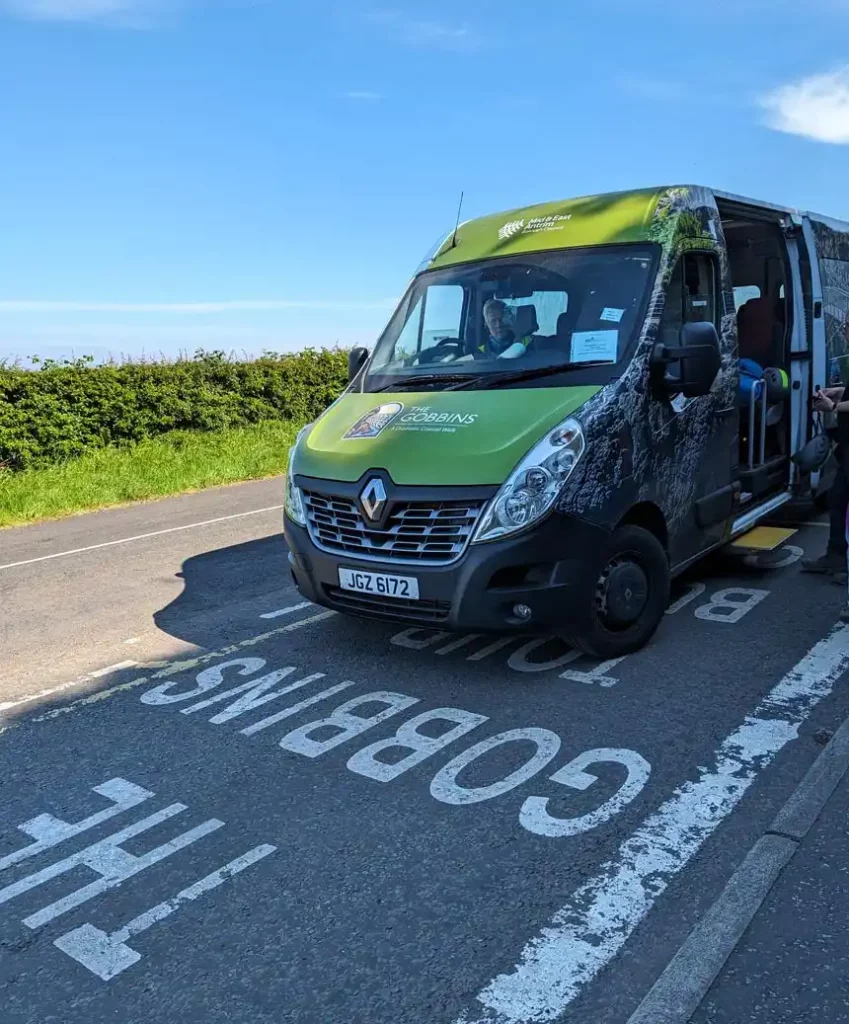
Booking your walk
To walk the Gobbins, you must book a guided tour in advance. Tours are available every day of the week, with more time slots during the summer and at weekends. There’s a maximum of 15 places on each tour so it’s essential to book early, especially during peak season. We visited on a Monday in May, and some tours were already full when I booked our trip around 3 days in advance.
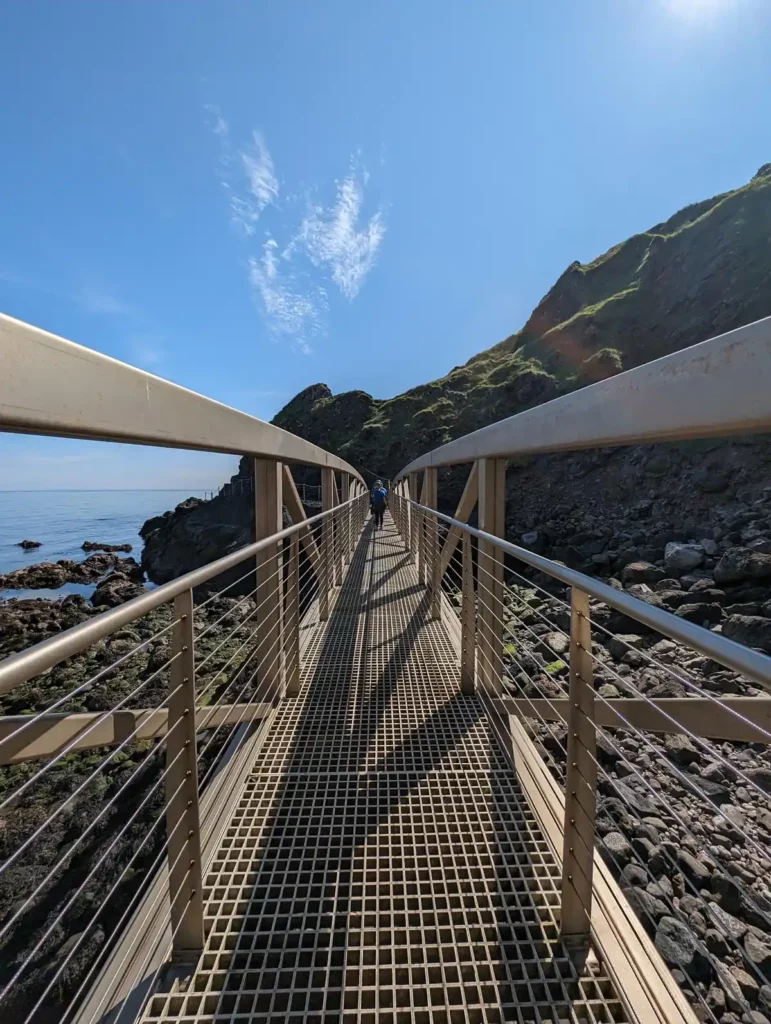
If you have a choice of times, and you can plan your day around your trip to the Gobbins, then you might want to choose a tour at high tide when the waves are more spectacular. Our tour was at low tide, and it was still amazing, but it looks incredible at high tide! You can check tide times for Larne, which is just up the coast from the Gobbins, on the Tide Times website.
You can book your tour online through the official Gobbins website. As of June 2024, tickets cost £21.50 for adults and £15.50 for children. Children must be at least 4ft/1.2m tall (the height of an average 7 year old) to be allowed on the walk.
Getting to The Gobbins
The Gobbins visitor centre is located near the village of Ballystrudder on the Islandmagee peninsula, approximately 40 minutes drive from Belfast. If you’re driving, take the A2 towards Larne and follow the signs for The Gobbins. There is a dedicated car park at the visitor centre, but it’s not quite big enough, so get there early.
If you’re relying on public transportation, you can take a train from Belfast to Larne and then take a taxi or bus to the Gobbins visitor centre. It’s essential to plan your journey in advance and allow plenty of time to arrive for your scheduled tour. Remember that you need to report to the reception desk at least 15 minutes before your tour.
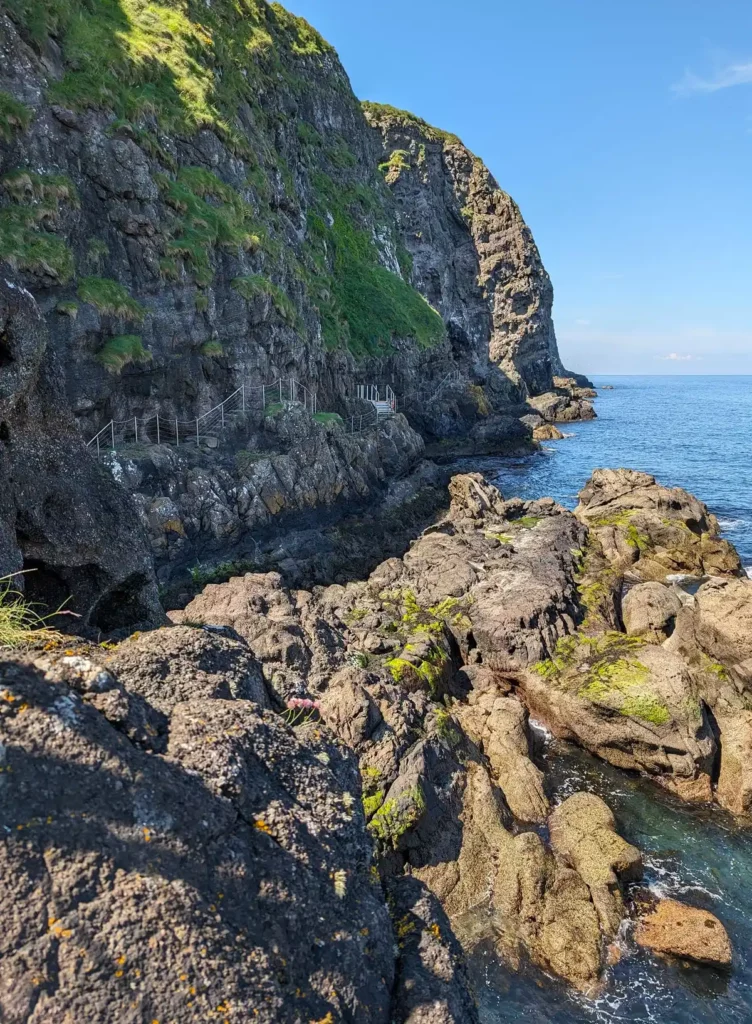
Tips for your visit to the Gobbins
- Wear hiking boots. You won’t be allowed on the Gobbins hike unless you’re wearing sturdy walking boots with a good grip. If you only have walking shoes, you may be allowed to wear them if it’s dry. Otherwise, you’ll have to rent walking boots from the visitor centre, as long as they have them available.
- Dress for the weather. The Gobbins is exposed to the elements, and walks go ahead in all weathers, as long as it’s still safe. Make sure you bring a waterproof jacket if there’s a chance of rain and layers if it’s cold or windy.
- Don’t forget your camera. The Gobbins is spectacular, so you’ll want to take some photos. While you can’t bring a bag, you can bring your phone, a camera on a neck strap or an action camera on a body harness.
- Pack some water, and save some for the end! Climbing the hill to get back up to the bus stop is absolutely the most strenuous part of the hike – you’ll be very glad of a drink when you get to the top. I’m a bit prone to fainting and I was also glad I had something sugary with me, even if it’s a bit against the rules.
- Go to the toilet before you set off. There are no facilities after you set off from the visitor centre until you get back 2.5 hours later, so go to the toilet and try not to drink too much before you get on the bus!
- Be realistic about your fitness levels. As our guide said, the Gobbins is remote; it’s difficult to get down there and difficult to get help if someone gets into trouble on the path. The Gobbins is only recommended for people with a reasonable level of fitness, which isn’t all that helpful a description as “reasonable” is pretty relative.
I’m quite lazy (honestly the odd Pilates class and 20k steps a day on holiday are as active as I get) and was worried about whether I’d be able to manage it but it was ok. The tall steps are a bit of a challenge if you’ve got short legs like me, but apart from the horrible hill at the end, it wasn’t too bad. I was the slowest person in our group to get back up the hill and our guide was happy to walk with me, I didn’t feel under pressure to rush. - It may not be for you if you’re scared of confined spaces or heights. I don’t love a confined space so I wouldn’t have wanted to be in the cave for a long time, but walking through was ok. If you are claustrophobic, you can ask the guide if you can go at the front of the group to get it over with. The path on the bridges is a kind of metal mesh, so you can see the sea below you; it’s not very high above the ground but if it’s making you feel a bit anxious then you might want to give the Gobbins a miss.
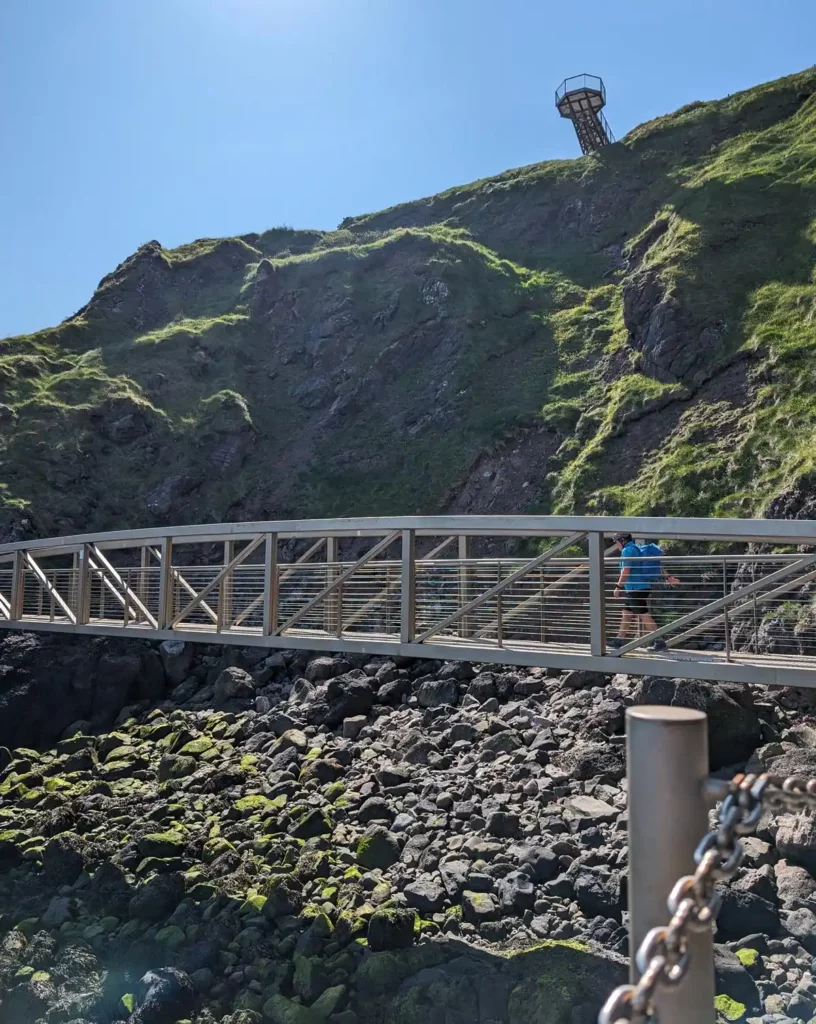
There is a viewing platform at the top of the cliff, which juts out over the cliff edge. Unfortunately you’ll need to either walk to it from the visitor centre or get a taxi as there’s no parking nearby.
In summary
Walking the Gobbins cliff path is an unforgettable experience that combines natural beauty, history, and adventure. Whether you’re a seasoned hiker or simply looking for a unique way to explore the Northern Irish coastline, the Gobbins is one of the best things to do in Northern Ireland.
I hope this blog post has inspired you to visit the Gobbins and provided helpful information for planning your trip. If you have any questions or would like to share your own experiences, please let me know in the comments section below!

